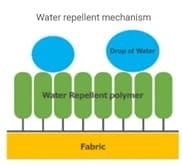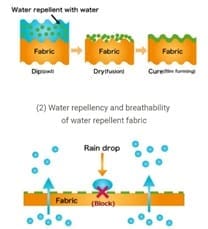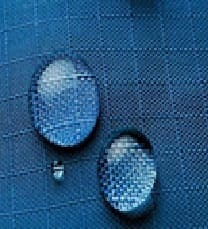Highlights:-
- Fluorocarbon (FC) gives fiber surfaces the smallest amount surface energies of the repellents finishes in use.
- Even though perfluorocarbon are successful in providing water repellent properties, its products are in the negative list of environmental associations because to their toxic properties.
- Finishing procedures that are formed on nanostructured surface roughness will be of extreme importance to give both fluorine-free repellent finishes and also durability in the mean of self-healing properties.
- Introduction
Water Repellent is finish that is used on the fabric by adding is a Repellent processing agent that covers the surface of fiber by nanoparticle compound and provides the fabric good water repellency. This process also gives washing durability.
The benefit of this finishing is that it can contain the authentic hand of fabric itself by not losing air permeability as it is not coating finish covering the fabric fully along with thick resins.
- These are the final goods of Water repellent Finish:
Suit, Umbrella, Surgical gown, Outdoor garments, Carpet, Automotive engine filter, Cardboard, Coat, etc…
- Mechanism of the process:-
 https://nctexchem.com/product/process/finishing/waterrepellent/
https://nctexchem.com/product/process/finishing/waterrepellent/
To increass the water repellency and durability, the important point is the way water repellent is regularly bonded to the fiber at the molecular level and stabilized on the fiber surface.
In order to achieve that these are important:
① To produce compounds (polymers) structure so that molecular chains are organized well.
② Set up a process for evenly and durably joining it with the developed compound to the surface of the fibre.

By infusing the fabric with a water repellent and then heat treating it at extreme temperature, the water repellent nanoparticles attaches to every single fiber.
As the whole fabric is not coated, the fabric stays breathable and repels water.
- FLUOROCARBON BASED REPELLENTS
Fluorocarbon (FC) gives fiber surfaces the smallest amount surface energies of the repellents finishes in use. FC repellents are mixed by including perfluoro alkyl groups into acrylic or urethane monomers that can be then polymerized due to which fabric finishes made. Application of the end polymer, when will be done on the fiber, which will form fabric that presents a opaque CF3 external surface for high repellency. The stretch of per fluorinated side chains has to be around 8-10 carbons, the little spacer group, usually ethylene,may be changed to improve the emulsification and solubility of the polymer. Co monomers (X, Y, for instance stearylorlauryl-methacrylate, butyl acrylateetc) affect .fabric hand, film formationand sturdiness. during this way and by appropriate emulsifiers, FC products will be widely modified for several special performance profiles. Most FC products are padded, dried and cued. Eat treatment forms an orientation of the performance side chain nearly crystalline structures.
This is ìmportant for optimal repellency. Washing and cleanup disturb this orientation and decreases finish performance. The orientation must be caused by the latest heat treatments (ironing; pressing, or tumble drying). reckoning on the type of blocking groups, the isocyanine is activated at different temperatures so reacts with the functional groups of the FC, the fiber or with itself (cross linking). This attachment on the fiber surface gives durability to washing, cleaning and rubbing as next necessary effect.
Low curing FC’s are new development. They get repellency without heat, only after drying attemperature,. An evitable disadvantage is their low durabilitydue to the shortage of fixation ‘by cross linking. It saves cost and energy.
- Water Repellency Testing
Standard temperature: – relative humidity – 65% and 20oC
Tester name: Spray tester
Sample size: 50 cm circumference.
- Procedure:
The sample fabric is attached on the embroidery hoop and set up on the tester at 45o.
Then with the help of beaker water is added to th funnel with 250 cc.
The water is poured with the help of spray nozzle on the fabric.
After spraying is conpleted the sample holder is taken off and the extra water is also taken off by tapping the frame 6 times against any solid object.
The evalution of the water repellency is done by referring to the spray rating chart.
5 tests are done and the closest rating is allotted to everyone, as no interpolation is permitted, that means a rating for a specimen cannot be 75.The denotion of the 5 ratings is accepted as the final result.
- Conclusion
Even though perfluorocarbon are successful in providing water repellent properties, its products are in the negative list of environmental associations because to their toxic properties. That is why, new trends of water-repellent finishes with less side effects on mankind and nature are higher in demand. Nanotechnology has introduced worthy achievements and many researches are going to be in focus in the coming years. Finishing procedures that are formed on nanostructured surface roughness will be of extreme importance to give both fluorine-free repellent finishes and also durability in the mean of self-healing properties. Nanoparticles and application methods resulting in water-/oil-repellent properties along with other multifunctionalities such as self-cleaning, antibacterial, flame retardant, and UV protection will be also concerned in future.
References:-
https://nctexchem.com/product/process/finishing/waterrepellent/
https://textilelearner.blogspot.com/2013/08/repellent-finishing-mechanism-of.html?m=1
https://textilelearner.blogspot.com/2012/02/water-repellency-water-repellent.html?m=1

